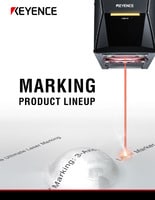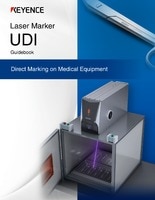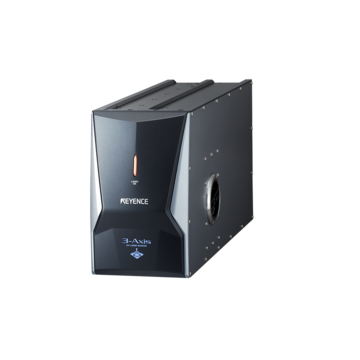Laser Marking Systems / Laser Markers
Understanding 2D Codes for Laser Marking
-
Tags:
- Laser Marking , Automotive , Electric Vehicle

Product traceability has emerged as an important aspect of modern manufacturing. It helps on a variety of fronts, including regulatory compliance, quality control, and supply chain management. Among the various marking technologies available, laser marking of 2D codes stands out for its durability, precision, and reliability.
Regardless of the type of 2D code used, they contain critical information that tracks products throughout their lifecycle, making them a great choice for industrial applications.
Types of 2D Codes Used in Laser Marking
Unlike traditional one-dimensional barcodes that store limited information, 2D codes offer a much higher data capacity in a compact design. By encoding data both horizontally and vertically, they can store extensive information while occupying minimal space. Here are some of the most common types of scanning codes used in industrial settings:
- Data Matrix Codes: These square or rectangular codes consist of black and white cells arranged in a pattern. Data Matrix codes can store up to 2,335 alphanumeric characters and maintain readability even when up to 30% of the code is damaged. Their high data density and error correction capabilities make them ideal for marking small components in the automotive, electronics, and aerospace industries.
- QR Codes: Initially developed for Japan's automotive industry, Quick Response (QR) codes have gained widespread popularity as they can store up to 7,089 numeric characters or 4,296 alphanumeric characters. While similar to Data Matrix codes, QR codes feature distinctive square patterns in three corners, aiding in rapid reading. They're commonly used when consumer interaction is desired alongside industrial traceability.
- Aztec Codes: Named for their resemblance to Aztec pyramids, these codes feature a square bullseye pattern at their center. Aztec codes don't require a quiet zone (blank margin) around the symbol, making them space-efficient. They're commonly used in the transportation industry, particularly for electronic tickets.
- PDF417 Codes: These stacked laser marking barcodes function as a hybrid between 1D and 2D codes. While technically classified as 2D due to their information capacity, they arrange data in stacked rows. PDF417 codes can store up to 1.1 kilobytes of data and are often used for identification cards, inventory management, and shipping labels.
We’re here to provide you with more details.
Reach out today!

How Laser Marking Works for 2D Barcodes
Laser marking systems represent the most durable and precise method for creating 2D codes on industrial parts. The process uses a laser beam that is focused to make permanent, high-contrast marks on various materials through different mechanisms:
- Laser Engraving: The laser vaporizes material from the surface, creating a recessed impression that forms the code pattern. This approach delivers excellent results on metals, plastics, and ceramics, generating profound markings that withstand abrasion and harsh environmental conditions.
- Laser Etching: This process melts the material surface, causing it to expand and leaving a raised mark with a strong contrast. Laser etching is ideal for metals and certain plastics, as it produces visible marks even in low-light conditions.
- Laser Annealing: Used primarily on metals, annealing changes the material's surface color through controlled heating without ablation. This technique creates high-contrast marks without compromising the material's integrity or corrosion resistance—critical for laser marking in the medical industry and aerospace components.
- Laser Foaming: When applied to plastics, the laser creates a foaming effect that produces light-colored marks on dark backgrounds. This technique delivers excellent contrast for optimal readability.
The laser marking process offers several advantages over traditional marking methods:
- Permanence: Unlike labels or inkjet printing, laser codes resist fading, abrasion, extreme temperatures, and chemical exposure.
- Precision: Lasers can create extremely fine details, producing high-density codes that remain readable despite their small size.
- Material Versatility: Laser marking works on metals, plastics, ceramics, glass, and many other materials.
- Non-contact Process: Since the laser never touches the part, there's no mechanical stress or wear on the components.
- Environmental Benefits: The process uses no consumables, generates no waste, and minimizes environmental impact.
Best Practices for Laser Marking 2D Codes
To ensure the best readability and longevity of laser-marked 2D codes, there are a few proactive considerations to keep in mind.
- Material Considerations: Laser energy has varying effects depending on the materials being used. To achieve maximum contrast and durability, the laser parameters (power, frequency, focus, and speed) can be adjusted based on each of their respective properties.
- Code Placement: Position codes on flat, accessible surfaces whenever possible. When marking curved surfaces is unavoidable, adjust laser focus and parameters to maintain consistent mark quality across the contour.
- Code Size Optimization: Balance the need for compactness with readability. At the same time, modern scanners can read extremely small codes; however, factors such as material surface finish and reading distance influence the minimum viable size.
- Error Correction Levels: Implement appropriate error correction levels based on the anticipated environmental conditions and potential damage. Higher levels of error correction increase code reliability but require larger code sizes.
- 2D Code Reading: Implement in-line reading systems to ensure code quality right after marking. This ensures readability throughout the product's lifecycle and prevents potentially harmful codes from entering the supply chain.
- Contrast Enhancement: For materials where achieving sufficient contrast is challenging, consider pre-treatment or post-processing to enhance visibility. KEYENCE lasers offer built in parameter optimization by material to assign settings to each unique material that is marked.
- Regular Maintenance: Keep laser optics clean and properly aligned to maintain consistent marking quality. Implement preventive maintenance schedules to avoid degradation in code quality over production runs.
As industrial traceability requirements evolve, laser marking of 2D codes will remain a leading source of permanent identification solutions. These versatile marks allow for seamless tracking across the entire product lifecycle, from raw materials to end-of-life processing, thereby supporting quality control, anti-counterfeiting measures, and regulatory compliance.
Understanding 2D codes and laser marking techniques allows manufacturers to create reliable traceability systems that enhance efficiency and ensure compliance with strict industry standards. When implemented effectively, these compact yet powerful markings play a crucial role in modern manufacturing’s digital transformation.
No matter your laser marking or coding needs, KEYENCE offers versatile solutions designed to adapt across industries and tackle a wide range of applications. Contact us today to speak with a specialist or schedule a product demo.
Contact us to learn more about how our advanced technology can help take your business to the next level.
Contact Us
Related Downloads

2D codes are used to store date codes, lot codes, serial numbers, and more. Users who are considering 2D code marking should read this laser marking guidebook.





